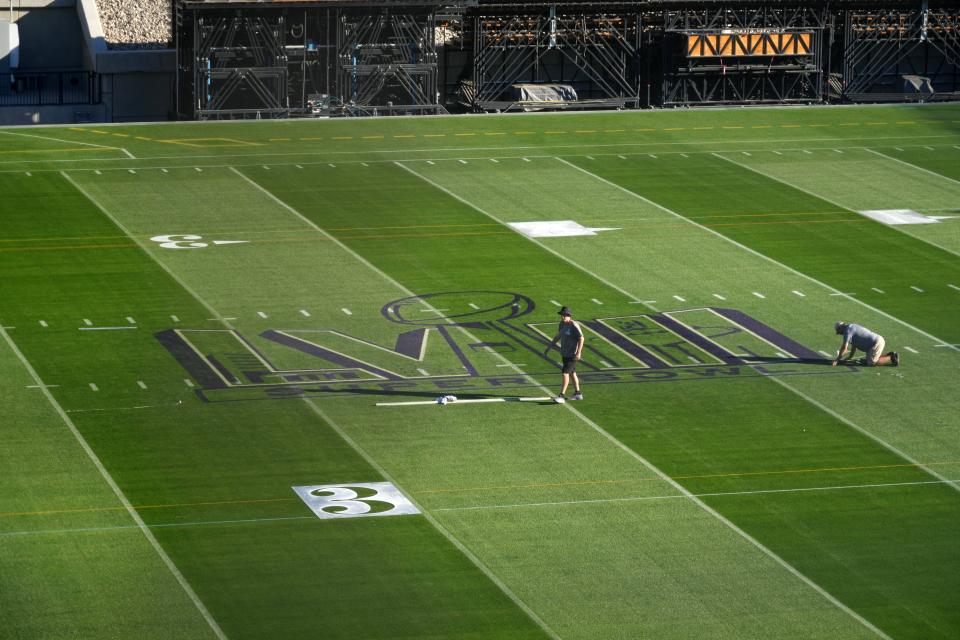'It's not rocket science': NFL turf debate rages on although 92% of players prefer grass
LAS VEGAS — As NFL Players' Association executive director Lloyd Howell toured the 32 organizations in the league throughout the 2023 regular season, he listened to players' concerns over a wide variety of issues. For a union with a membership around 2,000 individuals, finding a consensus to address any one issue can be a problem.
Howell quickly realized which one had the most unanimity: players' desires to play on grass fields instead of turf.
The topic — already relevant ahead of Super Bowl 58 as the San Francisco 49ers voiced concerns ahead of their matchup against the Kansas City Chiefs — was the primary theme of Howell's first public appearance as leader of the union since he was named to the position over the summer.
“It’s unquestionable that our union wants to have a working condition where they get to play on grass,” Howell said Wednesday.
A survey conducted by the NFLPA that included 1,700 respondents had a 92% response rate of players saying they preferred to play on high-quality grass rather than synthetic turf. Six percent are indifferent, according to the survey.
For Howell, the subject of grass versus turf extends beyond the aesthetics of the game. It's a workplace issue. Playing on turf could decrease a player's career by two or three seasons, he said.
“That’s meaningful to our union," Howell said. "That’s dollars to them and their families and the trajectory of their lives. That’s a difference in what kind of chronic pain they’ll be in for the rest of their lives.”

NFLPA president JC Tretter, a former offensive lineman, said injury data can be spliced a number of ways. In two of last three seasons, the turf injury rate has decreased and approached the rate with which soft-tissue, lower-body injuries occur on grass.
“Narrative-wise, when you put that out there, people think turf has gotten safer," Tretter said.
Tretter added that’s because grass had its highest injury rate of the past decade in 2023. But it’s worth pointing out, he said, that it’s still lower than turf.
Los Angeles Chargers running back Austin Ekeler said that turf burn can last for weeks. He also notices a difference in how his body bounces off concrete compared to grass. Turf is “sticky.” There is more give on grass.
“It’s not like, ‘Oh my God, I played on a turf field,’ where it’s like overwhelmingly sore the next day," Ekeler said. "But it’s little accumulations of those little things that make it less preferable.”
In the case of the Niners' practice field problems, experts informed the union that the softer surface could put San Francisco players at risk on game day. Tretter said a plastic layer between the turf and grass is typically laid down but wasn’t in this case for some reason.
“'Playable' is not the same standard as 'high-quality,'” Tretter said. “That’s about as low as you can go to say it’s OK. So we can’t kind of talk out of the both sides of our mouth.”
Last year, the grass field rolled in for Super Bowl 57 — which the NFL touted going into the Chiefs' matchup against the Philadelphia Eagles — did not hold up, as players slipped throughout the game.
Maintenance and quality of grass fields are important metrics when comparing turf to grass, Howell said. The union is currently working on creating another test to define playing surface standards, Tretter said. Right now, "Clegg Test" — official name "Clegg Impact Tester" — is the only one that currently exists. Ideally, the new metric would measure performance and safety.
“It doesn’t really tell you much,” Tretter said of the Clegg Test. “It just tells you the hardness of the field. It’s not a safety metric.
“It’s a 72? Great, what does that mean?”
Tretter pointed to players' complaints at the Carolina Panthers' home stadium during a Christmas Eve game in December. The turf was deemed too hard, and the game continued as planned.
This week, FIFA revealed that grass will be rolled into NFL stadiums that use turf for the 2026 men's World Cup.
“Another sport has figured out how to put down a grass field for its players," Howell said. "And that’s all we’re asking.
“This is really basic. It’s not rocket science.”
Lloyd said because of owners' varying viewpoints and the circumstances of each venue — climate, location, utilization — there isn’t a uniform answer for the 32 clubs. Jacksonville Jaguars kicker Brandon McManus said ownership and the union see eye-to-eye in the respect of wanting to keep the best players on the field.
“Whatever we can do to keep the best players (playing), is best for business,” he said.
Owners spend a lot of money on player salaries annually, McManus added.
“If their money’s not on the field, well, let’s look at the reasons why they’re not,” McManus said.
This article originally appeared on USA TODAY: NFL's grass fields vs. turf debate a top NFLPA issue
